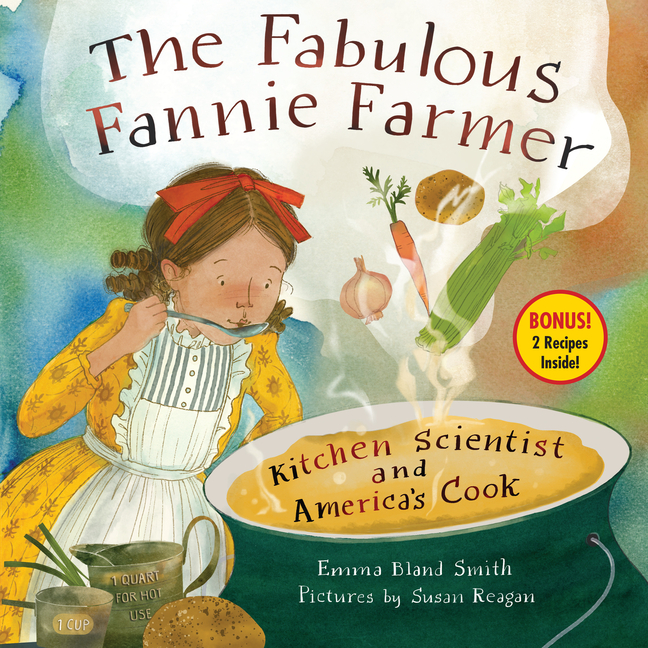Book Descriptions
for The Fabulous Fannie Farmer by Emma Bland Smith and Susan Reagan
From Cooperative Children's Book Center (CCBC)
Fannie Farmer loved cooking as a child. When she lost the use of a leg as a teenager due to polio, her love of cooking helped reshape her vision for the future; while she recovered, she cooked. Fannie noticed that the imprecise instructions and measurements in most recipes in the late 19th and early 20th centuries (e.g., “a suspicion of nutmeg”) made for inconsistent results. She enrolled in the Boston Cooking School and stayed on after graduation, eventually becoming principal. She led not only the school but the charge for using exact measurements and providing precise instructions in recipes, and showcased the results when she rewrote the school cookbook, which became a hit with the general public. This spirited recounting of the accomplishments of this food pioneer includes terrific end matter, beginning with a note about research and conjecture versus fact in the narrative before exploring many dimensions of Fannie’s life, work, legacy, and the times in which she lived. A design that highlights quotes from Fannie throughout, alongside pleasing watercolor and digital illustrations, round out this winning picture book biography.
CCBC Choices 2025. © Cooperative Children's Book Center, Univ. of Wisconsin – Madison, 2025. Used with permission.
From the Publisher
ALSC Notable Children's Book
CCBC Choices 2025
A NSTA-CBC Best STEM Book
2025 Texas Topaz List
2025 Rise: A Feminist Book Project Title
Fannie Farmer, America’s most famous cooking teacher, discovers that precise measurements are a recipe for cooking success in this STEAM picture book that includes two of her classic recipes.
★ School Library Journal, starred review
★ Youth Services Book Review, starred review
When Fannie Farmer learned to cook in the late 1800s, recipes could be pretty silly. They might call for “a goodly amount of salt” or “a lump of butter” or “a suspicion of nutmeg.” Girls were supposed to use their “feminine instincts” in the kitchen (or maybe just guess). Despite this problem, Fannie loved cooking, so when polio prevented her from going to college, she became a teacher at the Boston Cooking School. Unlike her mother or earlier cookbook writers, Fannie didn’t believe in feminine instincts. To her, cooking was a science. She’d noticed that precise measurements and specific instructions ensured that cakes rose instead of flopped and doughnuts fried instead of burned. Students liked Fannie’s approach so much that she wrote a cookbook. Despite skepticism from publishers, Fannie’s book was a recipe for success.
Written with humor and brought to life with charming illustrations, this book explores the origins of Fannie Farmer’s quintessentially American cookbook. A cookbook that was beloved because it allowed anyone to make tasty things, with no guessing, no luck—and certainly no feminine instincts—required.
CCBC Choices 2025
A NSTA-CBC Best STEM Book
2025 Texas Topaz List
2025 Rise: A Feminist Book Project Title
Fannie Farmer, America’s most famous cooking teacher, discovers that precise measurements are a recipe for cooking success in this STEAM picture book that includes two of her classic recipes.
★ School Library Journal, starred review
★ Youth Services Book Review, starred review
When Fannie Farmer learned to cook in the late 1800s, recipes could be pretty silly. They might call for “a goodly amount of salt” or “a lump of butter” or “a suspicion of nutmeg.” Girls were supposed to use their “feminine instincts” in the kitchen (or maybe just guess). Despite this problem, Fannie loved cooking, so when polio prevented her from going to college, she became a teacher at the Boston Cooking School. Unlike her mother or earlier cookbook writers, Fannie didn’t believe in feminine instincts. To her, cooking was a science. She’d noticed that precise measurements and specific instructions ensured that cakes rose instead of flopped and doughnuts fried instead of burned. Students liked Fannie’s approach so much that she wrote a cookbook. Despite skepticism from publishers, Fannie’s book was a recipe for success.
Written with humor and brought to life with charming illustrations, this book explores the origins of Fannie Farmer’s quintessentially American cookbook. A cookbook that was beloved because it allowed anyone to make tasty things, with no guessing, no luck—and certainly no feminine instincts—required.
Publisher description retrieved from Google Books.


